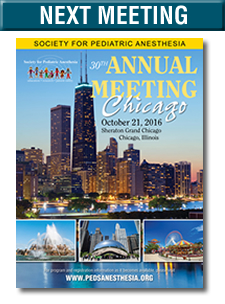SPACIES
Worlds Apart: How Vanderbilt Children’s Hospital Pediatric Anesthesia Fellowship Fosters Leadership Skills in Global Health
By Jenna Sobey, MD; Mark Newton, MD; Tom Romanelli, MD and Jacob Hummel, MD
Vanderbilt Children’s Hospital
The importance of global health exposure to medical trainees has become more apparent over the last two decades. According to a 2012 survey, when choosing a training program, anesthesia residents demonstrate an interest in global health opportunities in both residency and fellowship. The major barriers to participation tend to be obtaining permission from the program and coverage.1 The global health care disparities in low and middle income countries are profound, and in order to make a true impact, we must empower these countries to develop a sustainable infrastructure to solve these problems on their own. This requires education from high resource settings to establish the necessary framework, and in order for individuals to become involved in these endeavors, they first must have exposure to these settings. The educational benefits involved in this relationship are not limited to the low and middle-income communities, but also for the high resource instructors. There is much to be gained in cultural exposure, broadening one’s worldview, and enhancing leadership skills through these projects.
In order to address the paucity of anesthesia providers in low and middle-income countries, Vanderbilt has made it a priority to encourage and assist our trainees to participate in global health opportunities in anesthesia through elective rotations abroad. This year our pediatric fellowship program has taken the steps to integrate exposure to global heath as an option for trainees during their time in fellowship by gaining approval from the ACGME for a global pediatric anesthesia elective. The rotation is at Kijabe Hospital in Kijabe, Kenya and fellows are under the supervision of Dr. Mark Newton, who is a faculty member at Vanderbilt Children’s Hospital and who spends 70% of his time in Kijabe and 30% of his time at Vanderbilt. During the four-week long rotation the fellows are introduced to a wide array of pediatric surgical pathology they would likely never encounter or be expected to manage in the U.S. They experience new cultural boundaries and are afforded the opportunity to learn about how these restrictions can have a profound influence on medical care. They can see first-hand how resource limitations can easily dictate patient care, and how to adjust treatment algorithms accordingly in order to provide safe pediatric anesthesia in this setting. The fellows develop leadership and teaching skills to promote thoughtful, safe delivery of perioperative care in a setting where the learners are hungry for knowledge.
Our first fellow to participate in this new elective rotation, Dr. Jacob Hummel, traveled to Kenya in January of this year and his account of his experience is quite impactful.
It is an experience I hope every young physician has a chance to take. It was easily the most pivotal point in my education and training over the last decade of my life. The memories are numerous, too many to count, but they were also unique and profound. The memories started as soon as I got in the taxicab, as my first sights of Kenya were awe-inspiring and filled with wonder. The only other time I felt that awe was when I got on the bus in Nicaragua and saw the volcanoes off in the distance after arriving for my first medical mission trip. It was something I never thought I would feel again, but lucky am I that my trip turned out to be so much more than just those views.
This was not a glorified safari vacation with a token work schedule. After a few days of jet lag had passed, we were thrown into the mix. I was lucky to be accompanied by two young bright minds, Drs. Joel Musee and Patrick McConville, both residents at Vanderbilt. We had an idea of what to expect as anesthesiology residents from Vanderbilt had traveled and worked there before us, but it was still pretty cool to see each of us grab the opportunity and run with it. We found the Kijabe Hospital and community to be filled with talented and dedicated individuals. Some physicians were there to help out for a couple months, some were there for a year or two-year commitment, but most were permanent transplants. They were from all over the world and they brought their families with them to make this their home. We instantly felt the unique camaraderie of the physicians and their families and the community they had established. They were all driven for the cause and all appreciative of work we were doing.
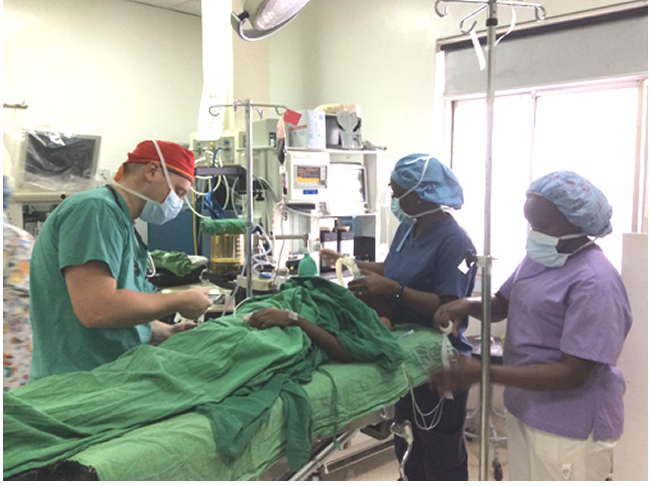
Dr. Hummel had the chance to instruct KRNA students intraoperatively, here ensuring safe inhalational induction techniques for children.
One of the big criticisms of medical mission work is that the practice of arriving and seeing a large number of patients and then leaving the next week does not provide much benefit to a community. I was happy to find that this was not the case in Kijabe. We were happy to find many forms of sustainability in the structure of the hospital and its staff. We became intimately involved with nurse anesthetist school that had been established by our mentor, Dr. Mark Newton, in which students from all across Kenya and even from neighboring countries (S. Sudan) had come to be trained. My colleagues and I gave them daily morning lectures and then followed along with them intraoperatively as well. The vast majority of the surgical cases in rural Kenya are performed by task-sharers, without the direct supervision of an anesthesiologist, so in order to continue to make progress in the safety of the Kenyan population, we must continue to train those, physicians and non-physicians, who can provide a high level of safe anesthesia in difficult environments.
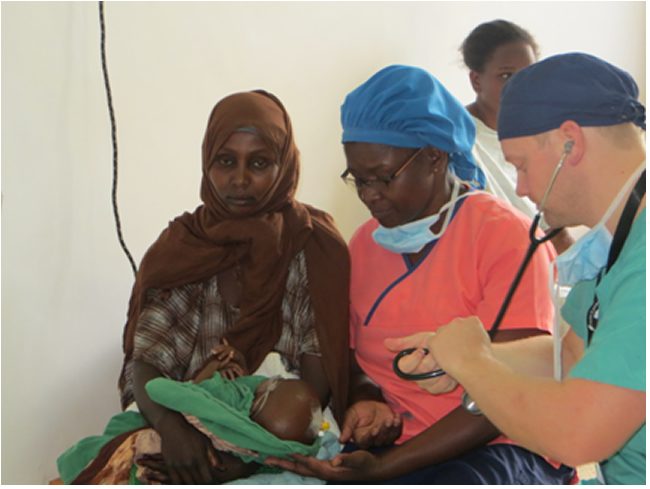
Dr. Hummel talking with the mother from Somalia that traveled over 16 hours to have her 7 month-old child cared for at Kijabe.
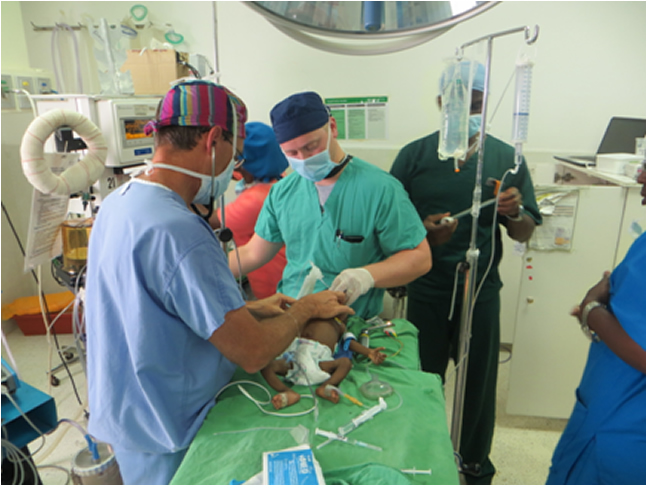
Dr. Mark Newton works closely alongside our fellows to ensure they adjust to the anesthesia conditions they will encounter in Kenya. Here he is assisting Dr. Hummel with induction in an infant.
Not only did I feel good contributing to a sustainable and beneficial project, but I felt an enormous sense of accomplishment with my personal growth as a physician. It is true that I would not have to leave the states to see my share of challenging cases, but once you have done an open aortic abdominal aneurysm repair in a low resource environment, practicing in the states will seem like a luxury!
A great example of the challenges we faced was the story of a mom and her 7-month old child who came to Kijabe for help. She was a single mother who had spent the last several months at a refugee camp near the border of Somalia and had an incredibly sick child. She somehow found her way to Kijabe, a bus ride of at least 16 hours! Her child had an unfortunate constellation of symptoms that we would characterize as a VACTERL or CHARGE syndrome. The child was in dire need of an abdominal procedure, as she weighed only 3 kilograms! Not to mention a loud systolic heart murmur with questionable oxygen saturations. A scary child to anesthetize in any scenario, but can you imagine having to take this child to surgery before having an echocardiogram? Unheard of in the states, but here an echocardiogram could take up to two weeks to get done, time this young child did not have. After watching the kid cry and noticing that my saturations remained relatively unchanged I felt like this was probably what we would classify as a left to right shunt.
Her echocardiogram two weeks later would prove me right, but in the moment it was exciting to know that I could still use the basic skills I learned in medical school to allow me to care for this child appropriately. Without bogging down the story with too many details, you will be happy to know the child had an uneventful anesthetic and surgical course. She would eventually be discharged, as she was feeding appropriately and beginning to gain some weight. The American practice of anesthesiology has the tendency to numb the soul and causes us to practice in line with the desires of insurers and lawyers rather than our patients. It felt liberating to feel this degree of empathy again as I cannot remember when I had been so invested in patient care. Remember when you first aspired to go to medical school? You wanted to be different from the other good students because you wanted to make a difference in people’s lives. I am still trying to hang onto that feeling in Kijabe and I will always keep that story in the back of my head as I encounter other challenging points in my career.
I think this opportunity calls for a certain amount of experience. If it had been six months prior, I may not have been ready for this situation. Surely every young physician should expect to encounter a certain amount of growth, but are you ready to take your care to the next level? As we try our best to help these countries escape their downward cycles, one has to be ready to contribute to the cause. You can sense that the people want to be on their own and freed of their reliance on aid and charity. If you feel you are on the cusp of making a great contribution and ready to embrace the challenge that lies ahead, I can tell you the satisfaction is quite sweet. Not quite as sweet as the delicious, fresh mango and pineapple you will eat every day, but still just as good!
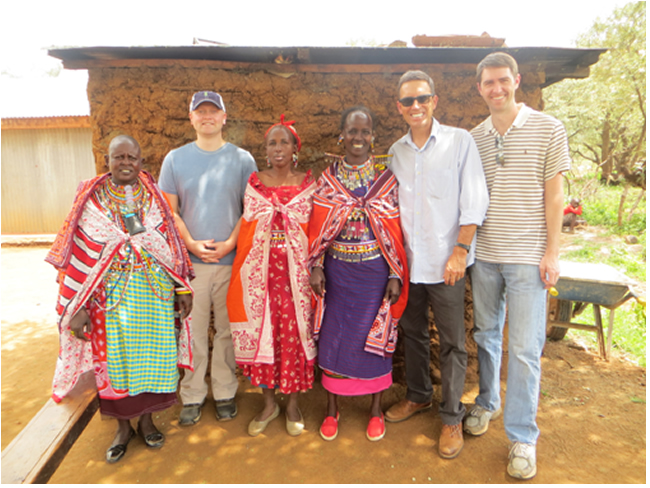
This rotation involves full immersion into African culture. Here, Dr. Newton took Dr. Hummel and Dr. McConville to a Masai village, where they were able to meet the people and spend the afternoon learning about their history and culture to gain a full appreciation for many of the patients they would be caring for.
UNICEF, outlining Africa’s demographics, quotes “It is projected that 1.1 billion children will be living in Africa in 2100, accounting for almost half (47%) of the world population of children at that time”.2 Bidirectional (East-West) academic partnerships focusing on the current deficits, and future massive needs, in providing safe pediatric anesthesia must begin now. The trend of young trainees (medical students, residents, fellows) who want to be involved in global activities within their chosen specialty will continue to grow and we need to develop models which are sustainable.
The Vanderbilt anesthesia leadership is privileged to offer this model which can be experienced during a trainee's formative years of anesthesia education. For those interested in global pediatric anesthesia, these structured programs can help the fellows directly impact the career of a future anesthesia care provider in Africa who can then have the knowledge and skill-set which could help improve the safety of pediatric surgery in Africa. In addition, mentors like Dr. Mark Newton, who possess a wealth of knowledge and experience in the global health community, also provide a unique career development opportunity for our pediatric anesthesia fellows at Vanderbilt Children’s Hospital that stretches far beyond the operating room.
Upon completion of the rotation, our fellows will have an appreciation for the profound benefits that our global health initiatives offer for working in high and low resource settings. Cross-cultural team-building, communication skills and cost-saving measures, without impacting quality of care, can all become sharpened with a structured global anesthesia rotation and are invaluable skills for fellows in training to acquire.
We hope this rotation will help develop the next generation of physician leaders in our specialty, while instilling a passion in these young pediatric anesthesiologists to continue their involvement and support of global health endeavors throughout their careers.
References
- McCunn M, Speck RM, Chung I, Atkins JH, Fleisher LA. Global health outreach during anesthesiology residency in the United States: a survey of interest, barriers to participation, and proposed solutions.
J Clin Anesth. 2012 Feb;24(1):38-43. doi: 10.1016/j.jclinane.2011.06.007. - You D, Anthony D. Generation 2025 and beyond: The critical importance of understanding demographic trends for children of the 21st century. Unicef, Occasional Papers. http://www.unicef.org/media/files/Generation_2015_and_beyond_15_Nov2012_e_version.pdf



